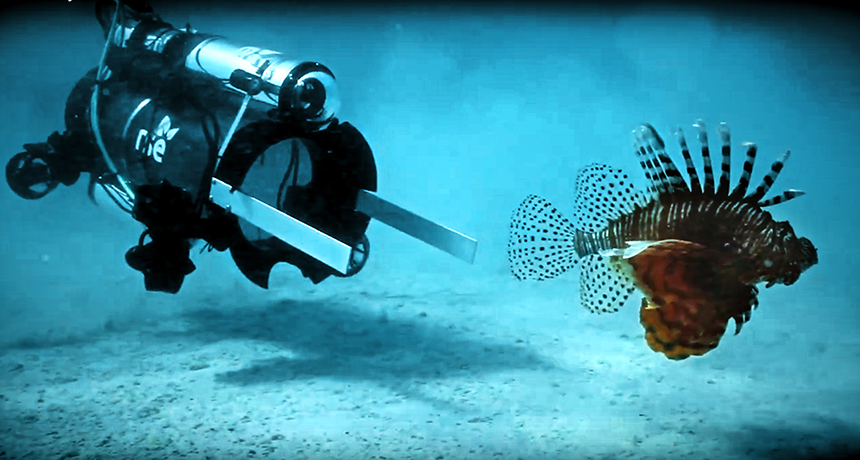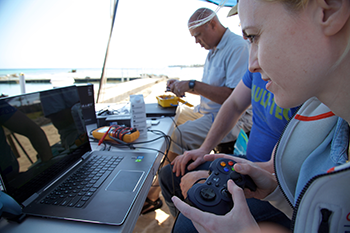Underwater robot vacuums up lionfish
It could remove the invasive ecosystem bullies from coral reefs and move them onto dinner plates

This lionfish doesn’t seem to notice the robot sneaking up behind it. A human steers the robot so its two metal bars will soon surround the fish. Then a jolt of electric current between the bars will stun the fish, allowing the robot to suck it into a holding tank.
J-P Rouja/LookBermuda
The beautiful but deadly lionfish has devastated coral reefs around Bermuda and other places in the Atlantic Ocean. Native to the Middle East and Pacific Ocean, lionfish have no natural predators here. They have become invasive species, which eat many native species on the reefs. But a new robot could help efforts to control the invaders. It captures these fish. And one day diners may eat the robot’s catch.
“It’s essentially a robotic vacuum that zaps and sucks fish,” says Erika Angle. She is a biochemist and co-founder of the biotechnology company Ixcela in Bedford, Mass. She also works with a number of non-profit and outreach organizations. One of them, Robots in Service of the Environment (RSE), built the lionfish-hunting robot. At an April 2017 demonstration, her team dropped several lionfish into a large, saltwater pool. It was near the ocean in the West Atlantic island nation of Bermuda. Angle sat nearby. Using the joystick from a video-game controller, she steered the underwater robot.

During the demo, Angle saw through the robot’s “eyes.” What that vision system picked up appeared on a laptop screen in front of her. Carefully, the scientist nudged the joystick on the controller. As she did, the robot scooted closer to a large, spiky lionfish.
A crowd of onlookers watched. Would Angle’s robot catch the fish? “Everybody was waiting with bated breath,” the scientist recalls. Finally, she pushed a button. Zap! The robot sent an electric shock through the water. This stunned the fish, which now drifted, motionless. The robot used this opportunity to slowly suck the animal into a holding chamber. The crowd cheered as Angle grinned.
Diving deep
Inspiration for the robot struck when she and her husband, Colin Angle, were vacationing in Bermuda. While scuba diving with some locals, they saw lionfish on the reef. On a boat after the dive, the group started talking about the invasive species. Several local residents had been dealing with lionfish for years. They knew that Colin Angle had co-founded the company iRobot, which makes robotic vacuum cleaners such as the Roomba. And so the group challenged the Angles to use robotics to help solve their lionfish problem.
And it’s a big problem, notes Stephanie Green. She’s a marine ecologist at Stanford University in California who is not involved in the robot project. Green compares the lionfish to a very thorny weed. A weed crops up in a garden, spreads quickly and chokes out most other plants. The lionfish is similar, but it is eating and outcompeting local fish.
Lionfish “mostly eat whatever fits in their mouth,” she says. And, she notes, over a two-year period, a reef infested with lionfish could lose 65 percent of its native prey fish.
Currently, divers help to control lionfish by nabbing them with spears or nets. Green herself has spent many hours underwater catching lionfish with nets. But people can only dive safely down to about 30 meters (100 feet). Lionfish hang out as deep as 122 meters (400 feet). Using a robot to reach these depths is “a really innovative idea,” says Green.
To bring that idea to life, the Angles recruited a team of engineers willing to volunteer their time. They tested early prototypes of the robot in a kiddie pool in a team member’s garage. To make the water as salty as the ocean, they would dump salt into the pool with a shovel and mix it up with a wooden beam. Then they would drop in the current version of the robot — and a lionfish. “Larry the lionfish was our test subject,” Erika Engle says. “He’s a trooper.”
Eat the invaders
Finally, the team was ready to show off its robot to the world. For the April event in Bermuda, they caught 13 lionfish over the course of the day out of the saltwater pool. Of course, a pool isn’t the same as a reef. But the team savored these moments. “The engineers threw off their shirts and went flying into the ocean in celebration,” Angle recalls.
The Angles and their team treated Larry, their test subject, with affection. But wild lionfish that their robot encounters won’t be so lucky. Erika Angle’s team hopes to sell robots to the fishing industry to capture lionfish for people to eat.
Most restaurants and grocery stores don’t yet offer lionfish. But activists are trying to change that. Eating the fish would be a great way to reduce its numbers. At the RSE launch event, a group of chefs competed to make the best recipe using with lionfish. Angle’s favorite was ceviche (Seh-VEE-chay). That’s raw fish marinated in citrus juice.
Green hopes that RSE’s robot will help tackle the explosion of lionfish in North American waters. But first she’d like the fish-catcher tested in a deep-ocean environment, not just a pool. She also is concerned about how much it might cost to run the robot. It could be too expensive. And she worries that wild lionfish will be tough to catch. These fish tend to approach unusual sights, such as divers or a robot. But they dart away quickly when spooked. Over time, they might learn to recognize and avoid a robot.
In a recent study, Green and her colleagues compared the behavior of lionfish living in areas with and without regular human hunting. The hunted fish hid more deeply in the reef by day. Green, however, is glad RSE is bringing attention to the lionfish problem.
And Angle’s team has big plans for its robot. They have considered letting people donate money to log into a website and control the robot remotely, almost like playing a video game. Or they might take human pilots out of the picture entirely. A drone robot that could recognize lionfish might be able to patrol the depths for the beautiful, spiky invaders on its own, then bring them into port.
Note: Angle is the founder and executive director of Science from Scientists, a program that brings hands-on research projects run by real scientists into schools. Her group’s mission is to improve student interest and aptitude in STEM. It sends scientists into classrooms every other week during the school day, so far in 46 schools. Angle also was a 1999 finalist of Science Talent Search, a program created by and still run by Society for Science & the Public (which also publishes Science News for Students).
This is one in a series presenting news on technology and innovation, made possible with generous support from the Lemelson Foundation.







